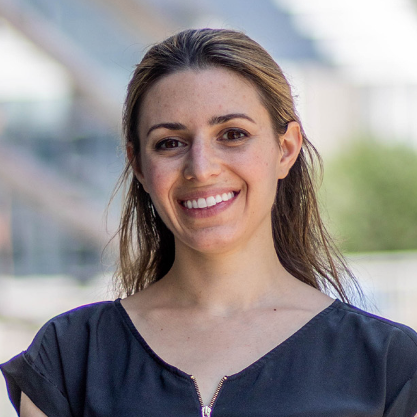April 2019: Christina Dimarino

Christina Dimarino
Assistant Professor
Department of Electrical and Computer Engineering
PhD Electrical Engineering, Virginia Tech
MS Electrical Engineering, Virginia Tech
BS Engineering, James Madison University
Email dimaricm@vt.edu
How do you see your work contributing to the goals and vision of IIHCC?
The goal of the Energy Theme within IIHCC is to improve energy infrastructure for the 21st-century world. The ways energy is generated and consumed are changing dramatically—we are going from large-scale, centralized power plants, to distributed, variable, renewable energy sources. There is also a significant increase in electrification—from all forms of transportation (cars, planes, trains, and ships) to buildings and industry. While these are exciting changes, they present significant challenges for our current energy infrastructure. Our power grid must become more flexible to accommodate these changes. Power electronics can achieve this by providing active, instantaneous power flow—they will send the power where it needs to be, when it needs to be there, in the form that is needed (e.g., AC or DC). This is not new. Power electronics have already revolutionized our portable electronics. They have dramatically increased the power management of the devices we use every day so that our batteries can be smaller and lighter and last longer. Now, we are scaling this up (significantly) to the higher voltages and power levels seen at the grid scale. We are going from tens of volts to tens and hundreds of kilovolts—a mere 1,000 times increase. My work will facil-itate the adoption of high-voltage wide-bandgap power semiconductors, which will be a key piece in creating high-voltage, high-power converters that will increase the flexibility and sustainability of our power grid. Additionally, this work will dramatically reduce the size and weight of high-power conversion systems, resulting in smaller power substations, and more efficient electric ships and large-scale renewable energy systems.
What other areas outside of your discipline would you entertain for future research and proposal work?
Successful integration of advanced power semiconductors, which are at the heart of switching power converters, requires an optimization of electrical, thermal, mechanical, and thermome-chanical characteristics. Accordingly, electronics packaging and high-density integration crosses many engineering and science fields. Bringing together expertise in these areas allows us to apply advanced methods and materials to improve performance and reliability, resulting in lower power consumption and longer product lifetimes, which are especially critical in grid, transportation, and off-shore wind applications. For the high-voltage wide-bandgap semiconductor devices, a major challenge is the high electric field strengths, which can result in corona discharge. A combination of new electrical, geometrical, and materials methods are being explored to grade the electric fields, thereby allowing us to create smaller, lighter, high-voltage power converters. In line with the IIHCC mission, my colleagues and I have also started collaborating with faculty in the College of Architecture and Urban Studies to explore how energy and design can create sustainable and human-centered buildings and communities. A prime example of what can be achieved with this type of collaboration is the FutureHAUS, which redefines conventional practices of modern home building through prefabricated structures and scalable renewable energy systems. We are also working with the Washington Alexandria Architecture Center to explore how to apply these concepts on the fusion of energy and design at the community level.


